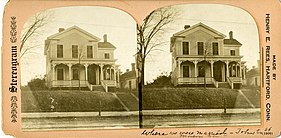
Back Stereoskopie Afrikaans Stereoskopie ALS تصوير ثلاثي الأبعاد Arabic Стереоскопия Bulgarian Estereoscòpia Catalan Stereoskopie Czech Stereoskopbillede Danish Stereoskopie German Τρισδιάστατη φωτογραφία Greek Stereoskopio Esperanto







Stereoscopy (also called stereoscopics, or stereo imaging) is a technique for creating or enhancing the illusion of depth in an image by means of stereopsis for binocular vision.[2] The word stereoscopy derives from Greek στερεός (stereos) 'firm, solid', and σκοπέω (skopeō) 'to look, to see'.[3][4] Any stereoscopic image is called a stereogram. Originally, stereogram referred to a pair of stereo images which could be viewed using a stereoscope.
Most stereoscopic methods present a pair of two-dimensional images to the viewer. The left image is presented to the left eye and the right image is presented to the right eye. When viewed, the human brain perceives the images as a single 3D view, giving the viewer the perception of 3D depth. However, the 3D effect lacks proper focal depth, which gives rise to the Vergence-Accommodation Conflict.
Stereoscopy is distinguished from other types of 3D displays that display an image in three full dimensions, allowing the observer to increase information about the 3-dimensional objects being displayed by head and eye movements.
- ^ "The Kaiser (Emperor) Panorama". 9 June 2012.
- ^ Cite error: The named reference
:0was invoked but never defined (see the help page). - ^ στερεός Tufts.edu, Henry George Liddell, Robert Scott, A Greek-English Lexicon, on Perseus Digital Library
- ^ σκοπέω, Henry George Liddell, Robert Scott, A Greek-English Lexicon, on Perseus Digital Library


